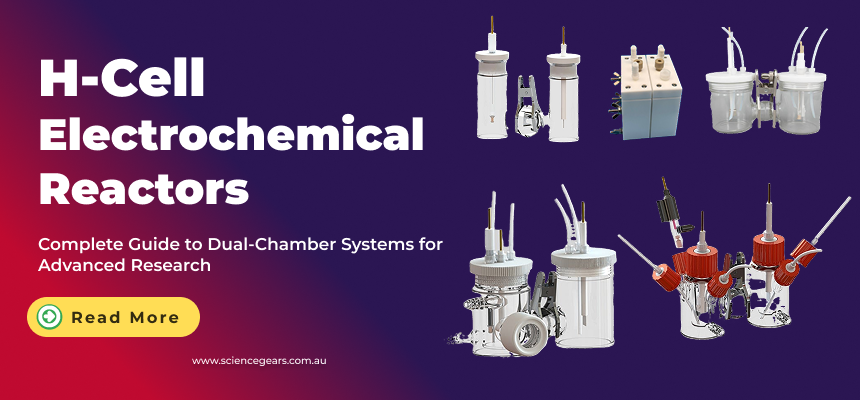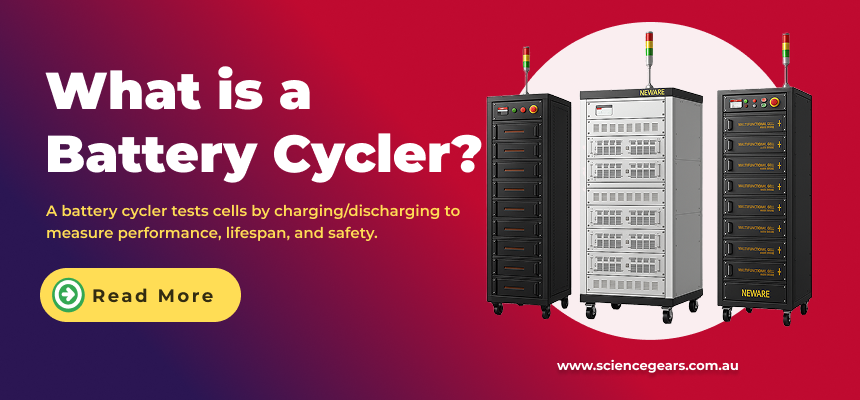What is an H-Cell?
An H-Cell is a dual-compartment electrochemical reactor that physically separates anodic and cathodic processes using an ion-exchange membrane, enabling independent control of reaction environments while maintaining ionic conductivity. Available in PTFE, glass, and jacketed configurations with standard capacities from 20 mL to 250 mL (and custom designs up to 1000 mL), H-Cells are essential for membrane characterisation, CO₂ reduction, hydrogen evolution, and photoelectrochemical research where electrode separation is critical.
Table of Contents
- What is an H-Cell and How Does It Work?
- Types of H-Cells Available at ScienceGears
- Key Features and Technical Specifications
- Applications of H-Cell Electrochemical Reactors
- Material Options: PTFE vs Glass vs Jacketed Designs
- H-Cell vs Flow Cell: When to Choose Each
- Membrane Selection and Replacement Guide
- Temperature Control in Jacketed H-Cells
- Buying Guide: Choosing the Right H-Cell Configuration
- Maintenance and Cleaning Best Practices
- Why Buy H-Cells from ScienceGears?
- Frequently Asked Questions
What is an H-Cell and How Does It Work?
An H-Cell is a specialised electrochemical reactor featuring two separate chambers connected in an "H" shape, divided by an ion-exchange membrane (e.g. cation- or anion-exchange membranes such as Nafion or Fumasep). This dual-compartment design enables researchers to isolate working and counter electrodes in distinct environments while permitting selective ion transport through the membrane.
The fundamental operating principle involves maintaining separate anolyte and catholyte solutions, preventing product crossover and enabling precise measurement of individual electrode reactions. Each chamber accommodates standard three-electrode configurations—working, counter, and reference electrodes—allowing comprehensive electrochemical characterisation without interference from opposing electrode reactions.
H-Cells excel in applications requiring strict compartmentalisation, including potentiometric studies, compound synthesis via bulk electrolysis, and microbial electrolysis where separation prevents unwanted side reactions. The membrane barrier enables selective ion transport between the two chambers, typically protons through cation-exchange membranes or hydroxide through anion-exchange membranes, while limiting product crossover, making H-Cells particularly valuable for measuring membrane selectivity, crossover resistance, and ionic conductivity.
Types of H-Cells Available at ScienceGears
ScienceGears offers seven specialised H-Cell configurations, each engineered for specific research requirements:
H-type Membrane Cell, Unsealed
The H-type Membrane Cell, unsealed provides open-access dual-compartment design ideal for rapid sample manipulation and educational demonstrations. Constructed from borosilicate glass with replaceable ion-exchange membranes, this configuration supports immediate intervention during experiments, making it perfect for method development and exploratory work.
Available capacities: 20 mL, 30 mL, 50 mL, 100 mL, 150 mL, 200 mL, 250 mL
Sealed H-Cell
The Sealed H-Cell features fully enclosed borosilicate glass chambers with PTFE and O-ring sealing components to minimise gas exchange and to allow separate venting or collection of anode and cathode gases. Ideal for anaerobic or oxygen-sensitive experiments, this configuration ensures minimal cross-contamination and leak-free operation for hydrogen evolution (HER), oxygen evolution (OER), and long-duration membrane performance testing.
Available capacities: 20 mL, 30 mL, 50 mL, 100 mL, 150 mL, 200 mL, 250 mL
Jacketed H-type Membrane Cell
The Jacketed H-type Membrane Cell incorporates water circulation jackets for precise temperature control during electrochemical experiments. The double-jacketed borosilicate glass construction enables researchers to maintain constant thermal conditions—critical for temperature-dependent reaction kinetics, catalyst performance evaluation, and corrosion studies under controlled environments.
Available capacities: 20 mL, 30 mL, 50 mL, 100 mL, 150 mL, 200 mL, 250 mL
PTFE H Type Membrane Electrolytic Cell
PTFE H Type Membrane Electrolytic Cell is manufactured entirely from chemically inert polytetrafluoroethylene (PTFE) and this variant offers superior resistance to aggressive electrolytes including concentrated acids, bases, and organic solvents. The PTFE construction offers outstanding resistance to aggressive acids, bases, and oxidising media that would damage glass cells, making it indispensable for extreme electrochemical environments; for very hot or highly oxidising media, confirm seal and O-ring compatibility with ScienceGears before extended runs.
H type Sealed Jacketed Photoelectrochemical Cell
The H type Sealed Jacketed Photoelectrochemical Cell combines gas-tight sealing, temperature control, and optical access through quartz windows (typically 24 mm diameter). This configuration enables photo-driven electrochemistry including solar water splitting, photocatalytic CO₂ reduction, and semiconductor photoelectrode characterisation under controlled illumination and thermal conditions.
Available capacities: 20 mL, 30 mL, 50 mL, 100 mL, 150 mL, 200 mL, 250 mL
H Type 3-Port Jacketed Photoelectrochemical Cell
The H Type 3-Port Jacketed Photoelectrochemical Cell features three additional ports for gas sampling, reference electrode placement, or electrolyte management alongside temperature-controlled operation. The removable 24 mm quartz windows provide UV-Vis transparency for photoelectrocatalytic studies including hydrogen evolution, CO₂ reduction, and solar fuel generation.
Available capacities: 20 mL, 30 mL, 50 mL, 100 mL, 150 mL, 200 mL, 250 mL
Three-Chamber H-Cell (Triple H-Cell)
The Three-Chamber H-Cell offers precision-engineered separation of anode, cathode, and intermediate reaction zones using multiple membranes. This advanced configuration enables electrodialysis, electro-organic synthesis, desalination research, and multi-stage electrochemical processes requiring complete compartmentalisation.
Available capacities: 20 mL, 30 mL, 50 mL, 100 mL, 150 mL, 200 mL, 250 mL
Key Features and Technical Specifications
H-Cells from ScienceGears incorporate precision engineering for reliable electrochemical research:
Dual Chamber Volumes: Ranging from 20 mL to 250 mL per compartment as standard, with customisable volumes up to 1000 mL available upon request
Three-Electrode Compatibility: Standard working, counter, and reference electrode configurations with ground-glass joints for secure electrode mounting
Membrane Interface: User-supplied ion-exchange membranes (Nafion, Fumasep, or custom membranes) with replaceable designs using PTFE support holders or stainless steel clips
Optical Access (PEC models): Quartz windows ranging from 20–34 mm diameter for light penetration, compatible with solar simulators, LED, and laser sources
Temperature Control Options: Jacketed variants with hose barb connections (typically 1/4″) for circulating water baths or external temperature controllers
Gas-Tight Sealing: O-ring and PTFE cap assemblies minimise atmospheric contamination, with dedicated gas inlet/outlet ports for purging, venting, or separate gas collection during long electrolysis runs
Chemical Resistance: Borosilicate glass construction resists most electrolytes; PTFE variants handle extremely corrosive chemicals including concentrated acids and oxidisers
Modular Design: Quick assembly and disassembly for membrane replacement, electrode changes, and thorough cleaning between experiments
Applications of H-Cell Electrochemical Reactors
H-Cells enable diverse electrochemical research applications across multiple scientific disciplines:
Membrane Characterisation and Testing
H-Cells serve as the standard platform for measuring ion-exchange membrane properties including selectivity, crossover resistance, ionic conductivity, and permeability. Researchers employ these systems to evaluate Nafion, anion-exchange membranes, and novel membrane materials under realistic electrochemical conditions.
CO₂ Reduction and Carbon Capture
Electrochemical CO₂ reduction reaction (CO₂RR) to valuable products like CO, formate, ethanol, and acetic acid relies on H-Cell configurations for initial catalyst screening. The dual-compartment design prevents product oxidation at the counter electrode while maintaining optimal pH conditions in each chamber.
Hydrogen and Oxygen Evolution Reactions
H-Cells facilitate water-splitting research for hydrogen production (HER) and oxygen evolution (OER) by separating evolved gases and reducing H₂/O₂ mixing, while enabling separate gas handling for safer operation. This configuration enables accurate Faradaic efficiency measurements and long-term catalyst stability testing.
Photoelectrochemical Water Splitting
Photoelectrochemical cells with quartz windows enable solar-driven water splitting, semiconductor photoelectrode characterisation, and photocorrosion studies under controlled illumination. The separated compartments allow independent analysis of photoanode and photocathode performance.
Nitrogen Reduction Reaction (NRR)
Electrochemical ammonia synthesis from nitrogen gas employs H-Cells to prevent ammonia oxidation at the anode while optimising cathode conditions for nitrogen reduction. The membrane barrier ensures accurate ammonia quantification without interference from anodic products.
Electro-Organic Synthesis
Bulk electrolysis for synthesizing organic compounds benefits from H-Cell separation, preventing valuable products formed at the working electrode from reacting with byproducts at the counter electrode. This isolation improves yield and simplifies downstream purification.
Fuel Cell and Battery Research
H-Cells support fundamental studies of fuel cell reactions, redox flow battery systems, and lithium recovery processes where separate anolyte and catholyte compositions are required.
Corrosion and Sensor Development
Corrosion testing under controlled electrochemical conditions and electrochemical sensor development utilise H-Cell configurations for precise potential control and interference-free measurements.
Material Options: PTFE vs Glass vs Jacketed Designs
Selecting the appropriate H-Cell material depends on experimental requirements, chemical compatibility, and thermal control needs:
PTFE (Teflon) H-Cells
Advantages: Exceptional chemical inertness resists concentrated acids (H₂SO₄, HNO₃, HF), strong bases (NaOH, KOH), organic solvents, oxidisers (Cl₂, Br₂, H₂O₂), and corrosive mixtures like aqua regia. Lightweight, virtually indestructible, and enables replaceable membrane designs with rapid assembly.
Best For: Harsh chemical environments, organic electrolytes, high-concentration acids/bases, and applications requiring frequent disassembly
Limitations: Opaque construction prevents optical measurements; higher cost than glass alternatives
Borosilicate Glass H-Cells
Advantages: Transparent for visual monitoring, compatible with most aqueous electrolytes, autoclavable for sterilisation, and more economical than PTFE variants. Superior optical clarity enables UV-Vis spectroscopy integration and reaction observation.
Best For: Standard aqueous electrochemistry, educational demonstrations, visual monitoring applications, and photoelectrochemistry requiring optical access
Limitations: Susceptible to breakage; limited resistance to concentrated HF and extremely strong alkaline solutions at elevated temperatures
Jacketed Glass H-Cells
Advantages: Combines borosilicate glass benefits with integrated water circulation jackets for precise temperature control (typically ±0.5°C). The double-wall construction enables heating or cooling via external circulators while maintaining optical transparency.
Best For: Temperature-dependent kinetic studies, thermally activated processes, catalyst screening across temperature ranges, and experiments requiring isothermal conditions
Limitations: Increased cost and complexity; larger footprint; requires external temperature control equipment
H-Cell vs Flow Cell: When to Choose Each
Understanding the fundamental differences between H-Cells and flow cells helps researchers select optimal configurations:
H-Cell Advantages
Simplicity: Straightforward setup with minimal auxiliary equipment; ideal for fundamental studies and catalyst screening
Cost-Effective: Lower capital investment compared to flow cell systems with pumps, mass flow controllers, and gas management
Flexibility: Easy electrode changes, membrane swapping, and electrolyte adjustments during experiments
Educational Value: Transparent operation aids teaching electrochemistry fundamentals and membrane behavior
H-Cell Limitations
Mass Transport: Limited by CO₂ solubility in aqueous electrolytes (~33 mM at 25°C, 1 atm), often limiting achievable current densities to <50 mA/cm² under these conditions
Long-Term Stability: Requires periodic electrolyte refreshment as dissolved reactants deplete; cation transport through membrane can disrupt ionic balance over extended operation
Scale-Up Challenges: Geometry and mass transport characteristics differ significantly from industrial-scale systems
Flow Cell Advantages
High Current Densities: Continuous reactant supply enables current densities exceeding 200 mA/cm² through gas diffusion electrodes (GDEs)
Enhanced Mass Transport: Direct gas-to-catalyst interface eliminates CO₂ solubility limitations
Industrial Relevance: Architecture more closely resembles commercial electrolyzers, facilitating technology transfer
Prolonged Operation: Continuous electrolyte circulation maintains stable composition for extended stability testing
When to Choose H-Cells
Select H-Cell configurations for:
- Initial catalyst screening and fundamental mechanism studies
- Membrane characterisation and ion transport measurements
- Educational demonstrations and method development
- Photoelectrochemical research requiring optical access
- Applications not requiring industrial-scale current densities
- Budget-conscious research programs or laboratories without flow infrastructure
When to Choose Flow Cells
Flow cells are preferred for:
- High-rate electrolysis targeting commercial viability (>100 mA/cm²)
- Long-term stability testing beyond 100 hours
- Gas diffusion electrode (GDE) development
- Scale-up studies and techno-economic assessments
- Applications requiring continuous product collection
Many research programs employ both architectures sequentially—using H-Cells for initial screening followed by flow cell validation.
Membrane Selection and Replacement Guide
Ion-exchange membranes form the critical barrier in H-Cell systems, and proper selection ensures optimal performance:
Common Membrane Types
Nafion (Cation/Proton Exchange Membrane): Industry-standard perfluorinated sulfonic acid (PFSA) membrane offering excellent proton conductivity, chemical stability, and mechanical durability. Common grades include Nafion 112 (≈50 µm), Nafion 115 (≈127 µm), and Nafion 117 (≈183 µm) to match different resistance and selectivity requirements.
Anion Exchange Membranes (AEM): Conduct anions (e.g. OH⁻) while limiting proton and cation crossover. Widely used in alkaline or near-neutral electrochemical systems, AEM water electrolysis, CO₂/NRR cells, and membrane characterisation studies.
Bipolar Membranes: Combine cation- and anion-exchange layers (often with a water-dissociation interface) for applications requiring simultaneous acid and base generation, such as salt splitting and advanced electrodialysis.
Ceramic and Solid-State Electrolytes: Emerging and specialised membranes for high-temperature or specific-ion transport applications.
Membrane Installation Steps
- Cut membrane to appropriate diameter (typically 2–5 cm larger than chamber opening for secure sealing)
- Pre-treat membrane according to manufacturer specifications—Nafion is commonly cleaned in 3% H₂O₂ at ~80°C to remove organics, then acid washed (1 M H₂SO₄ at 80°C for 1 hour), followed by thorough deionised water rinsing
- Hydrate membrane in deionised
- water for at least 30 minutes before installation
- Position membrane between chambers using PTFE support holders or stainless steel clips
- Ensure even pressure distribution across membrane surface to prevent leakage
- Verify seal integrity by filling one chamber and checking for leaks before commencing experiments
Membrane Maintenance
Store unused membranes in protective solution (dilute acid or water depending on type) in sealed containers to prevent drying and performance degradation. Replace membranes showing visible damage, excessive crossover, or increased resistance. Typical Nafion membranes maintain performance for months with proper care and storage.
Temperature Control in Jacketed H-Cells
Jacketed H-Cells enable precise thermal regulation critical for temperature-dependent electrochemical processes:
Temperature Control Setup
Connect jacketed cell hose barbs (typically 1/4″ diameter) to external recirculating water bath or temperature controller using flexible tubing. Ensure continuous circulation at adequate flow rate (typically 0.5–2 L/min) for uniform temperature distribution.
Temperature Range and Accuracy
Standard water circulation systems maintain temperatures from -20°C (with appropriate coolants) to +80°C with stability of ±0.5°C. Specialised high-temperature oils extend upper limits beyond 100°C for specific applications.
Applications Requiring Temperature Control
Kinetic Studies: Determining activation energies and reaction mechanisms through temperature-dependent current-voltage measurements
Catalyst Optimisation: Screening electrocatalyst performance across operating temperature ranges relevant to practical applications
Phase-Change Processes: Investigating electrochemistry at solid-liquid or liquid-gas transitions
Thermal Stability Testing: Evaluating membrane and electrode degradation under thermal stress
Temperature-Sensitive Reactions: Maintaining optimal conditions for enzymatic electrochemistry or reactions with narrow temperature windows
The integrated jacket design provides superior temperature uniformity compared to external heating, minimizing thermal gradients that can affect electrochemical measurements.
Buying Guide: Choosing the Right H-Cell Configuration
Selecting the optimal H-Cell requires evaluating experimental requirements, chemical compatibility, and research objectives:
Determine Chamber Volume Requirements
Calculate required electrolyte volume based on electrode size, experiment duration, and sampling needs. Smaller volumes (20–50 mL) suit rapid screening and precious electrolyte conservation, while larger volumes (100–250 mL) support extended experiments and bulk electrolysis.
Assess Chemical Compatibility
Match cell material to electrolyte chemistry—borosilicate glass for most aqueous systems, PTFE for aggressive acids/bases and organic solvents. Review electrolyte composition against material compatibility charts provided by manufacturers.
Evaluate Sealing Requirements
Choose sealed configurations for oxygen-sensitive reactions, gas evolution studies, or volatile electrolytes. Unsealed designs offer convenience for rapid parameter adjustments and educational settings.
Consider Optical Access Needs
Photoelectrochemical applications require quartz window configurations with appropriate diameter and transmission wavelength range. Ensure window diameter accommodates your light source beam diameter with margin for alignment.
Temperature Control Necessity
Jacketed variants suit kinetic studies, catalyst screening across temperatures, or reactions requiring isothermal conditions. Standard cells suffice for ambient-temperature work, reducing cost and complexity.
Port Configuration
Multi-port designs (3-port variants) provide flexibility for additional reference electrodes, gas sampling, or in-situ spectroscopy integration. Standard configurations offer simplicity for routine measurements.
Budget Considerations
Entry-level unsealed glass H-Cells provide excellent value for method development and teaching. Investment in jacketed, sealed, or PTFE variants returns value through expanded experimental capabilities and chemical compatibility.
Future Expansion Plans
Consider compatible accessories including reference electrodes, working electrodes, counter electrodes, gas management systems, and temperature controllers when planning long-term laboratory infrastructure.
Maintenance and Cleaning Best Practices
Proper maintenance extends H-Cell lifespan and ensures consistent electrochemical performance:
Post-Experiment Cleaning Protocol
- Immediately disassemble cell after experiments to prevent fouling and deposits
- Remove electrodes and membrane, storing membrane in appropriate solution if reusable
- Rinse all glass or PTFE components thoroughly with deionised
- water
- For stubborn deposits, soak in dilute acid (5% HCl or H₂SO₄) or base (5% NaOH) depending on fouling type
- Rinse extensively with deionised water after chemical cleaning
- Air dry completely before reassembly or storage
Glass Component Care
Avoid mechanical shock and thermal stress that can crack borosilicate glass. Store in padded locations. Inspect regularly for chips, cracks, or scratches that compromise integrity.
PTFE Component Care
PTFE resists chemical attack but requires proper storage away from direct sunlight to prevent discoloration. Clean with appropriate solvents for organic residues; PTFE tolerates virtually all cleaning agents.
O-Ring and Seal Maintenance
Inspect O-rings before each assembly for cuts, compression set, or chemical degradation. Replace damaged seals immediately to maintain gas-tight operation. Store spare O-rings in appropriate materials (EPDM for aqueous, FFKM for organic solvents).
Membrane Storage
Store unused or lightly-used membranes submerged in protective solution (deionised water for Nafion, appropriate electrolyte for other types) in sealed containers. Prevent drying which causes irreversible pore shrinkage and performance loss.
Port and Joint Inspection
Regularly inspect ground-glass joints for contamination or etching that impairs sealing. Clean joints with appropriate solvents and light abrasion if necessary. Lubricate sparingly with electrochemistry-compatible grease.
Long-Term Storage
For cells not used within 10 days, perform thorough cleaning, ensure complete drying, and store in clean, dry environment. Protect quartz windows from scratches using protective covers.
Following these protocols maximizes H-Cell reliability, reproducibility, and operational lifespan while minimizing experimental artifacts from contamination or degradation.
Why Buy H-Cells from ScienceGears?
ScienceGears delivers comprehensive H-Cell solutions backed by expertise and Australian support:
Extensive Product Range
Seven specialised H-Cell configurations spanning unsealed, sealed, jacketed, PTFE, photoelectrochemical, and three-chamber designs with standard capacities from 20 mL to 250 mL and custom designs up to 1000 mL. This breadth ensures researchers find optimal solutions for diverse applications.
Customisationised
Capabilities
ScienceGears accommodates custom specifications including non-standard volumes, additional ports, alternative optical window diameters, specialised membrane compatibility, and integration with in-situ spectroscopy systems. Contact technical team to discuss bespoke requirements.
Quality Materials and Construction
High-purity borosilicate glass, optical-grade quartz windows, chemically resistant PTFE components, and precision engineering ensure durability, chemical compatibility, and reproducible results.
Complete System Solutions
Beyond H-Cells, ScienceGears supplies compatible reference electrodes (Ag/AgCl, SCE, Hg/HgO), working electrodes (glassy carbon, platinum, custom substrates), counter electrodes, and gas management accessories for turnkey system integration.
Expert Technical Support
Local Australian expertise assists with cell selection, experimental design, troubleshooting, and optimisation—ensuring researchers maximize their investment and achieve research objectives.
Competitive Pricing
Direct sourcing and efficient operations deliver exceptional value without compromising quality, making advanced electrochemical research accessible to academic and industrial laboratories.
Reliable Delivery
Australian stock availability and established logistics ensure prompt delivery, minimizing research delays and enabling timely project completion.
Proven Track Record
Trusted by research institutions, universities, and industrial laboratories across Australia and internationally for electrochemical equipment that performs.
Frequently Asked Questions
What volumes of H-Cells are available?
ScienceGears offers H-Cells with chamber capacities ranging from 20 mL to 250 mL per compartment as standard, with custom volumes up to 1000 mL available upon request. Volume selection depends on electrode size, electrolyte requirements, and experiment duration.
Do H-Cells include ion-exchange membranes?
Membranes are typically user-supplied to ensure compatibility with specific experimental requirements. ScienceGears can provide membrane recommendations and sourcing assistance. Nafion membranes are widely available from chemical suppliers.
Can H-Cells perform optical measurements?
Photoelectrochemical H-Cell variants incorporate quartz windows (typically 24 mm diameter) enabling light penetration for solar water splitting, photocatalysis, and photoelectrode characterisation. Standard glass H-Cells permit visual monitoring but limited spectroscopy due to glass absorption characteristics.
How do sealed and unsealed H-Cells differ?
Sealed H-Cells feature gas-tight PTFE caps and O-ring seals preventing atmospheric exchange—essential for anaerobic experiments, gas evolution studies, and oxygen-sensitive reactions. Unsealed designs offer open access for rapid electrode changes and immediate intervention during experiments.
What is the purpose of jacketed H-Cells?
Jacketed configurations incorporate water circulation channels enabling precise temperature control (typically ±0.F5°C) via external recirculating baths. This capability is critical for temperature-dependent kinetic studies, catalyst optimisation, and isothermal reaction maintenance.
Are H-Cells compatible with potentiostats and power supplies?
All ScienceGears H-Cells accommodate standard three-electrode configurations compatible with commercial potentiostats, galvanostats, and electrochemical workstations. Electrode connections via ground-glass joints or PTFE ports enable secure, low-resistance electrical contact.
What maintenance do H-Cells require?
Routine maintenance involves thorough cleaning after each use, regular O-ring inspection and replacement, proper membrane storage, and careful handling to prevent glass breakage. Detailed protocols maximize cell lifespan and measurement reproducibility.
Can H-Cells be customised for specific applications?
ScienceGears offers extensive customisation including modified volumes, additional gas ports, alternative window sizes, specialised membrane mounts, and temperature control integration. Contact the technical team to discuss specialised requirements.
What is the difference between H-Cells and flow cells?
H-Cells provide simple dual-compartment configurations ideal for fundamental studies and catalyst screening, while flow cells offer continuous reactant supply enabling higher current densities suitable for scale-up and commercial development. Many research programs utilize both sequentially.
What reference electrodes work with H-Cells?
H-Cells accommodate all standard aqueous reference electrodes including Ag/AgCl, saturated calomel (SCE), mercury/mercurous sulfate, and mercury oxide electrodes via dedicated ports. Non-aqueous systems employ specialised reference electrodes compatible with organic electrolytes.
How do I select between PTFE and glass H-Cells?
Choose PTFE for harsh chemical environments (concentrated acids, strong bases, organic solvents) requiring maximum chemical resistance. Select borosilicate glass for standard aqueous electrochemistry, visual monitoring, and photoelectrochemical applications requiring optical transparency.
What electrodes are compatible with H-Cells?
H-Cells accept diverse working electrodes including glassy carbon, platinum, gold, ITO-coated glass, carbon paper, and custom catalyst-coated substrates; counter electrodes of platinum wire, mesh, or graphite; and reference electrodes appropriate for the electrolyte system.
Call to Action
Unlock Precision Electrochemistry with ScienceGears H-Cells
Whether you're advancing membrane technology, developing next-generation electrocatalysts, or pioneering photoelectrochemical systems, ScienceGears delivers H-Cell solutions engineered for your research success.
Request a Quote for your specific configuration or Contact Our Technical Team at info@sciencegears.com.au to discuss custom solutions tailored to your experimental requirements. Experience Australian expertise, quality construction, and dedicated support that accelerates your electrochemical research.
Explore our complete range of electrochemical cells and complementary accessories—empowering laboratories across Australia and beyond to achieve breakthrough discoveries.






